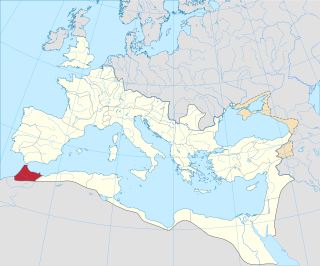
Mauretania is the Latin name for a region in the ancient Maghreb. It extended from central present-day Algeria to the Atlantic, encompassing northern present-day Morocco, and from the Mediterranean in the north to the Atlas Mountains. Its native inhabitants, of Berber ancestry, were known to the Romans as the Mauri and the Masaesyli.

Numidia was the ancient kingdom of the Numidians in northwest Africa, initially comprising the territory that now makes up Algeria, but later expanding across what is today known as Tunisia and Libya. The polity was originally divided between the Massylii in the east and the Masaesyli in the west. During the Second Punic War, Masinissa, king of the Massylii, defeated Syphax of the Masaesyli to unify Numidia into the first Berber state in present-day Algeria. The kingdom began as a sovereign state and later alternated between being a Roman province and a Roman client state.

Hippo Regius is the ancient name of the modern city of Annaba, Algeria. It historically served as an important city for the Phoenicians, Berbers, Romans, and Vandals. Hippo was the capital city of the Vandal Kingdom from 435 to 439 AD. until it was shifted to Carthage following the Vandal capture of Carthage (439).

The history of North Africa during the period of classical antiquity can be divided roughly into the history of Egypt in the east, the history of ancient Libya in the middle and the history of Numidia and Mauretania in the west.

Africa was a Roman province on the northern coast of the continent of Africa. It was established in 146 BC, following the Roman Republic's conquest of Carthage in the Third Punic War. It roughly comprised the territory of present-day Tunisia, the northeast of Algeria, and the coast of western Libya along the Gulf of Sidra. The territory was originally and still is inhabited by Berbers, known in Latin as the Mauri, indigenous to all of North Africa west of Egypt. In the 9th century BC, Semitic-speaking Phoenicians from West Asia built settlements along the coast of the Mediterranean Sea to facilitate shipping. Carthage, rising to prominence in the 8th century BC, became the predominant of these.

Cirta, also known by various other names in antiquity, was the ancient Berber, Punic and Roman settlement which later became Constantine, Algeria.

The Exarchate of Africa was a division of the Byzantine Empire around Carthage that encompassed its possessions on the Western Mediterranean. Ruled by an exarch (viceroy), it was established by the Emperor Maurice in 591 and survived until the Muslim conquest of the Maghreb in the late 7th century. It was, along with the Exarchate of Ravenna, one of two exarchates established following the western reconquests under Emperor Justinian I to administer the territories more effectively.

Mauretania Tingitana was a Roman province, coinciding roughly with the northern part of present-day Morocco. The territory stretched from the northern peninsula opposite Gibraltar, to Sala Colonia and Volubilis to the south, and as far east as the Mulucha river. Its capital city was Tingis, which is the modern Tangier. Other major cities of the province were Iulia Valentia Banasa, Septem, Rusadir, Lixus and Tamuda.

Cherchell is a town on Algeria's Mediterranean coast, 89 kilometers (55 mi) west of Algiers. It is the seat of Cherchell District in Tipaza Province. Under the names Iol and Caesarea, it was formerly a Roman colony and the capital of the kingdoms of Numidia and Mauretania.

Tingis or Tingi, the ancient name of Tangier in Morocco, was an important Carthaginian, Moor, and Roman port on the Atlantic Ocean. It was eventually granted the status of a Roman colony and made the capital of the province of Mauretania Tingitana and, after Diocletian's reforms, the diocese of Hispania.

Roman Carthage was an important city in ancient Rome, located in modern-day Tunisia.

Mauretania Sitifensis was a Roman province in Northwest Africa. The capital was Setifis.

The Praetorian Prefecture of Africa was an administrative division of the Byzantine Empire in the Maghreb. With its seat at Carthage, it was established after the reconquest of northwestern Africa from the Vandals in 533–534 by the Byzantine Emperor Justinian I. It continued to exist until 591, when it was replaced by the Exarchate of Africa.

Roman Tunisia initially included the early ancient Roman province of Africa, later renamed Africa Vetus. As the Roman empire expanded, the present Tunisia also included part of the province of Africa Nova.

Mauri was the Latin designation for the Berber population of Mauretania, located in the west side of North Africa on the shores of the Mediterranean Sea, Mauretania Tingitana and Mauretania Caesariensis, in present-day Morocco and northwestern Algeria.

Altava was an ancient Romano-Berber city in present-day Algeria. It served as the capital of the ancient Berber Kingdom of Altava. During the French presence, the town was called Lamoriciere. It was situated in the modern Ouled Mimoun near Tlemcen.

Sétifis, was a Roman town located in northeastern Algeria. It was the capital of the Roman province called Mauretania Sitifensis, and it is today Setif in the Sétif Province (Algeria).

Roman colonies in North Africa are the cities—populated by Roman citizens—created in North Africa by the Roman Empire, mainly in the period between the reigns of Augustus and Trajan.

The Roman Africans or African Romans were the ancient populations of Roman North Africa that had a Romanized culture, some of whom spoke their own variety of Latin as a result. They existed from the Roman conquest until their language gradually faded out after the Arab conquest of North Africa in the Early Middle Ages.
The Limes Mauretaniae was a portion of a 4,000-kilometre (2,500 mi) Roman fortified border (limes) in Africa approximately 100 kilometres (62 mi) south of the modern day Algiers.




















